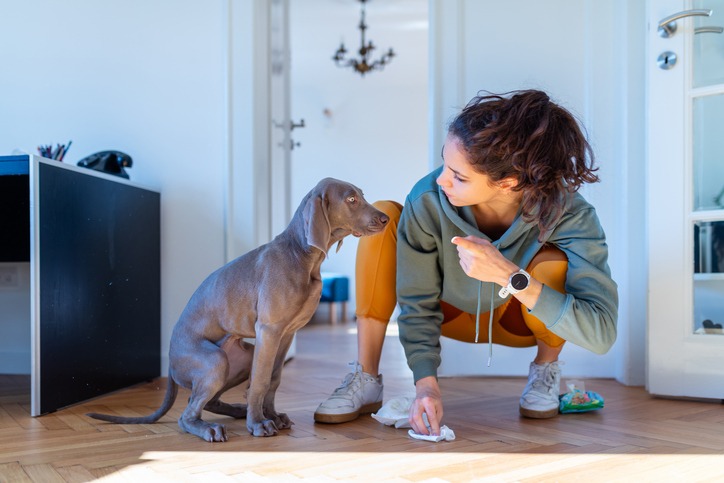Solving Your Puppy Potty Training Problems
Potty Training a Puppy
Do you have a new puppy? Congratulations. You’ve begun a wonderful journey of love and companionship that will last for many years. One of the first things you want to do for the sake of your relationship with your new puppy is start house training as soon as possible. Potty training puppies may seem tricky, but it can be very simple if you remain consistent, which means being on the same page with anyone else helping to train the puppy. Here, we offer some puppy potty training tips to help you get started.

How Long Does It Take to Potty Train a Puppy?
The answer to this question will vary, but it largely depends on you. The more consistent you are, the more quickly your lessons will “take”, and your puppy will be reliably housetrained. It could take a week or two for your puppy to be trained, but that does not mean that training time is over. Puppies often regress in potty training, and the overall process typically takes four to six months, as your puppy matures to adolescence. Until your puppy reaches about six to eight months old, it is going to be up to you to take them on frequent potty breaks and reward them for success.
Even with the best training, there will probably be some accidents. It could be that your puppy needs to be taken out more frequently than you realize, or it could be that something your dog ate is causing stomach upset and making it harder to wait. There could be a medical issue, or it could just be your dog’s breed. Small dogs often take longer to house train than larger dogs, simply because they have smaller bladders. For some reason, smaller dogs are also less inclined to want to go outside when the weather is bad. If you have been using potty pads indoors and are transitioning to an outside-only routine, you may experience some hiccups in your training while your puppy learns the new habit.
Signs Your Puppy Needs to Go Potty
Sometimes, your puppy will indicate a need to go outside with a subtle change in body language. While you’re house training your puppy, then, you will need to provide near-constant supervision, to prevent accidents. Signs that your puppy needs a potty break include:
- Suddenly stopping an activity
- Pacing or walking in circles
- Sniffing excessively
- Looking for somewhere more private
- Whining
- Sniffing or licking their groin area
- Pawing or jumping at the door
- Pawing at you or barking to get your attention
How to Potty Train a Puppy
- Choose a Regular Outside Potty Area. Decide where you’d like your puppy to regularly go to the bathroom. It could be a corner of your yard, a section of grass beside the sidewalk, or some other area. Look for a soft surface, because puppies often find gravel or rocks uncomfortable for walking. If your puppy is not fully vaccinated, avoid areas other dogs have used to avoid transmission of disease or illness. If you bring your puppy to the same spot each time, it will speed the process by allowing them to pick up smells from where they went previously, letting them know they should go again. Keep everything you need beside the door, including a leash, collar or harness, training treats, poop bags, and a flashlight. This will save you time when you need to quickly get your puppy outside, and will be especially helpful in the middle of the night. If you are using potty pads or disposable grass patches, choose a spot on an outdoor patio- (as long as it’s safe!)- or in an area far away from the puppy’s play and sleeping areas. Pick a spot that’s easy to clean, in case the puppy misses the pad. Tile is a much better option, for example, than carpet. If you plan to transition to an outdoor-only potty routine later, put the pee pads near the door to make the process easier.
- Puppy Potty Training Steps.
- Step one: Put your puppy on a leash and walk to the potty spot. Allow your puppy to sniff the area while you quietly wait.
- Step two: If your puppy goes potty, offer praise and a reward. Don’t act excited or offer a treat until the puppy is completely finished, because you don’t want to be a distraction.
- Step three: If the puppy does not go potty after a minute or two, go back inside. Don’t allow your puppy to play or explore on a potty break. You are trying to teach that rewards and play come after a successful potty trip, not before. Wait inside for five to ten minutes, keeping the puppy tethered to you with the leash to give you more of a sense of a need to go potty. Look for signs like sniffing the ground, turning in circles, or pacing, and take the puppy back outside. If the potty break is successful this time, you can allow your puppy a little bit of freedom to roam around the house, under your close supervision.
- Add a “Go Potty” Cue. This is easy to accomplish, just by creating an association of the words with the act of elimination. When you take the puppy out to the designated spot, say the cue you’d like to use, one time, in a natural tone of voice. Don’t act excited and distract the puppy, and don’t say it over and over as the puppy will think the repeated phrase is the cue. Reward your puppy for success and, eventually, he or she will associate the cue with going potty, and you will be able to use the cue to encourage your dog to go.
- Take Your Puppy to Their Potty Spot FREQUENTLY. This is probably the most important of all potty training puppy tips. You want your puppy to be successful at potty training, so you need the pup to be successful so you can give praise and a treat, reinforcing the behavior. The best way to encourage success is to provide plenty of opportunities, taking the puppy outside to the potty spot almost constantly. Once the puppy has learned that good potty behavior is rewarded, he or she will choose to go, and as the behavior is repeated, it will become a habit.
- Puppy Potty Training Schedule, by Age: Remember that part of the issue with potty training is that puppies can only “hold it” for so long. A good rule of thumb is to consider the number of months the puppy is old and add one, to come up with the number of hours he or she can wait between potty breaks. An eight-week-old puppy is two months old, so you’d add two plus one to get three hours. Plan regular potty breaks using that guide, but if you are just starting out with 8-week-old puppy potty training, take the puppy out more frequently, at least once every one to two hours, unless he or she is asleep. You should also take your puppy out:
- First thing upon waking.
- Right after a nap.
- 5–10 minutes after drinking water.
- After meals.
- Activity transitions, such as after a playdate with a puppy friend.
- Before and after puppy class.
What Not to Do When Your Puppy Has a Potty Accident
No matter how well you follow these potty training tips for puppies, accidents will happen from time to time. If you see your puppy going potty inside, interrupt the act by clapping your hands or calling the puppy’s name, then scoop your puppy up and go out to the potty spot. If he or she finishes going in the potty spot, give praise and a reward. If not, put the puppy in the crate or pen while you clean up the accident, then go outside again. What you should NOT do is:
- Yell, hit, or punish. Potty accidents are frustrating, but punishing the puppy can actually cause regression and damage the puppy’s trust in you. What’s more, if you punish after the accident has happened, the puppy doesn’t learn not to potty inside, just that you are scared. This is likely to cause your puppy to look for a hidden spot to potty inside where you won’t see.
- Rub a puppy’s nose in an accident. Never do this. It does not teach them anything and it creates a negative association with you. If you see that your puppy looks guilty, it’s not actually a sign of guilt, but of appeasement. It’s your puppy trying to indicate that he or she is no threat to you so that you won’t be angry.
- Neglect to thoroughly clean the spot. If your puppy can smell urine or feces in a spot, that’s an indication to the pup that it’s a potty spot and should be used in the future. Clean dog accidents with an odor-neutralizing cleaner made specifically for that purpose.
What Medical Issues Could Inhibit Puppy Potty Training?
If you are struggling to potty train your pup, it might actually have nothing to do with your technique. Talk to your vet to rule out any medical problems that could be undermining the puppy’s training. If your puppy is urinating in the house, it could be bladder inflammation, a urinary tract infection, bladder or kidney stone, liver disease, patent urachus, or an ectopic ureter. If the problem is poop, it could be intestinal parasites, an inflamed digestive system from too-rich foods, being fed too much, or a deficiency in pancreatic enzymes.
Contact Us at K-9 University for Reliable Dog Training in Plano and Garland, TX
When you need someone to help you care for your dog, trust the dedicated staff at K-9 University. Whether you need boarding, grooming, doggy daycare, or dog training services, we offer individualized attention and professional pet services honed from time-proven practices. We’ve served families in North Texas for over 30 years, and our highly trained, knowledgeable staff is available at our two convenient locations in Garland and Plano to provide training and pet care solutions to meet your needs. Call for more information or contact us through our website.
